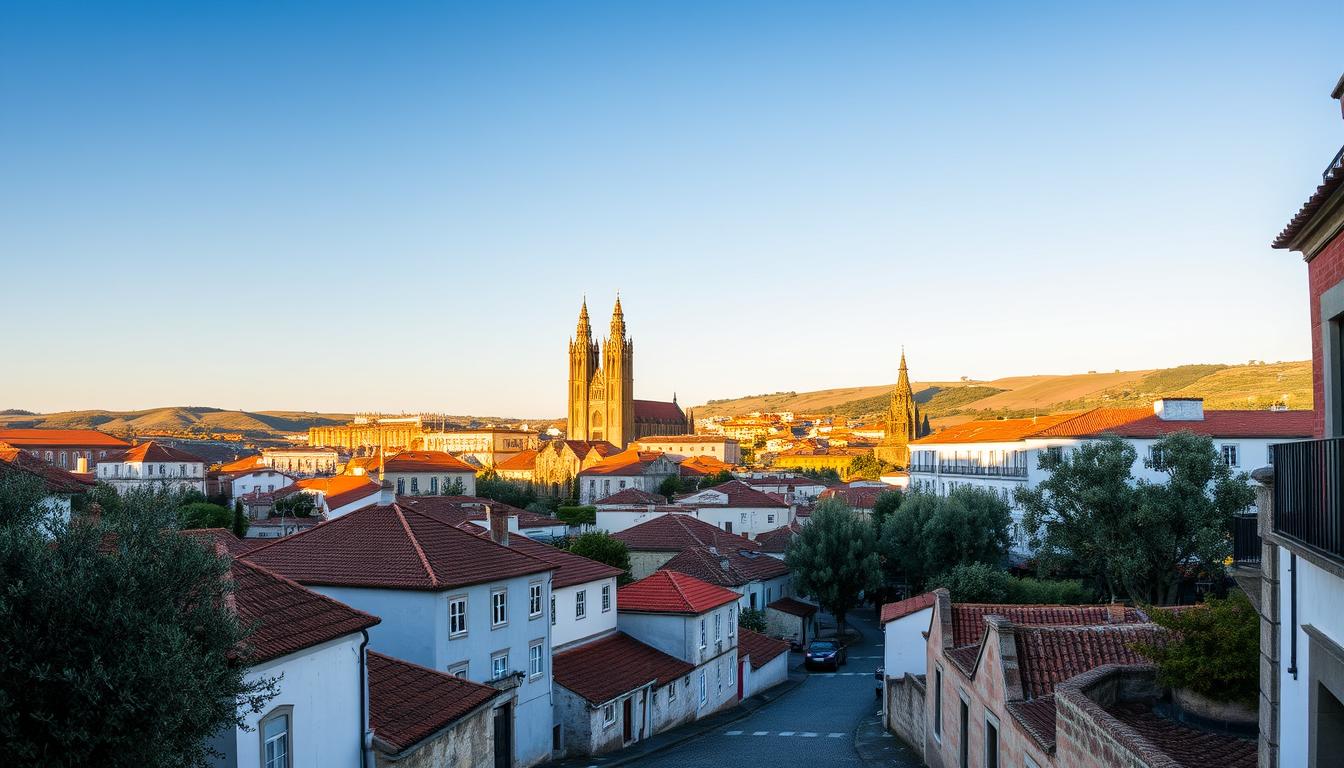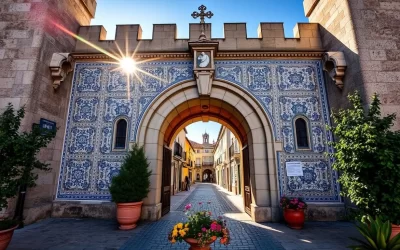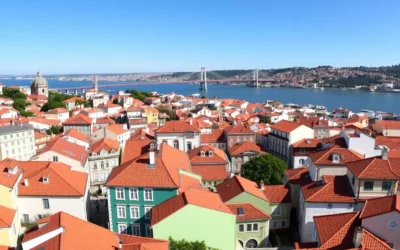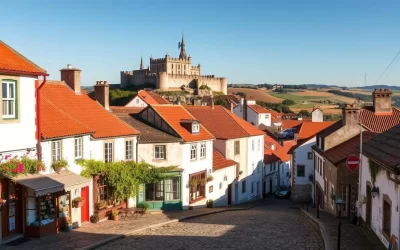✓ Accommodations✓ Flights✓ Rental Cars✓ Tours & Activities
Did you know that this charming city is home to a 2,000-year-old Roman temple? With its cobbled streets and fortress walls, this town offers a unique blend of history and modern vibrancy. It’s no wonder it’s a UNESCO World Heritage site.
Planning a trip here means stepping into a world where ancient landmarks meet local charm. From the Chapel of Bones to the stunning cathedral, every corner tells a story. This travel guide will help you uncover the must-see spots and hidden gems.
Get ready to explore historic sites, savor fine dining, and wander through picturesque streets. Your adventure in this enchanting place is just beginning.
Explore the Historic Roman Temple of Évora
Step into the heart of history at the Roman Temple, a marvel of ancient craftsmanship. This 2,000-year-old monument is one of the best-preserved relics of the Iberian Peninsula. Its towering columns and intricate design reflect the architectural genius of the Roman Empire.
History and Roman Influence
Built in the 1st century AD, the Roman Temple served as a central hub for city life. It was dedicated to Emperor Augustus, symbolizing Roman power and culture. Over the centuries, it has survived invasions and natural wear, standing as a testament to its enduring legacy.
The temple’s artistic details are equally fascinating. Its Corinthian columns and decorative motifs showcase the craftsmanship of ancient builders. Surrounding art and artifacts in nearby museums further enrich your understanding of this historic site.
Visitor Tips and Insights
To make the most of your visit, arrive early to avoid crowds. The temple’s reflective ambiance is best enjoyed during sunrise or sunset. Wear comfortable shoes, as the cobbled streets around the site can be uneven.
Don’t miss the nearby museum, which houses artifacts from the temple’s era. These exhibits provide deeper insights into the architecture and daily life of ancient Romans. Guided tours are also available for a more immersive experience.
Discover the Captivating Chapel of Bones
Step into a space where history and reflection intertwine at the Chapel of Bones. Built in the 17th century by Franciscan monks, this unique monument is both haunting and thought-provoking. Its walls and ceilings are adorned with meticulously arranged human bones and skulls, creating an eerie yet fascinating atmosphere.
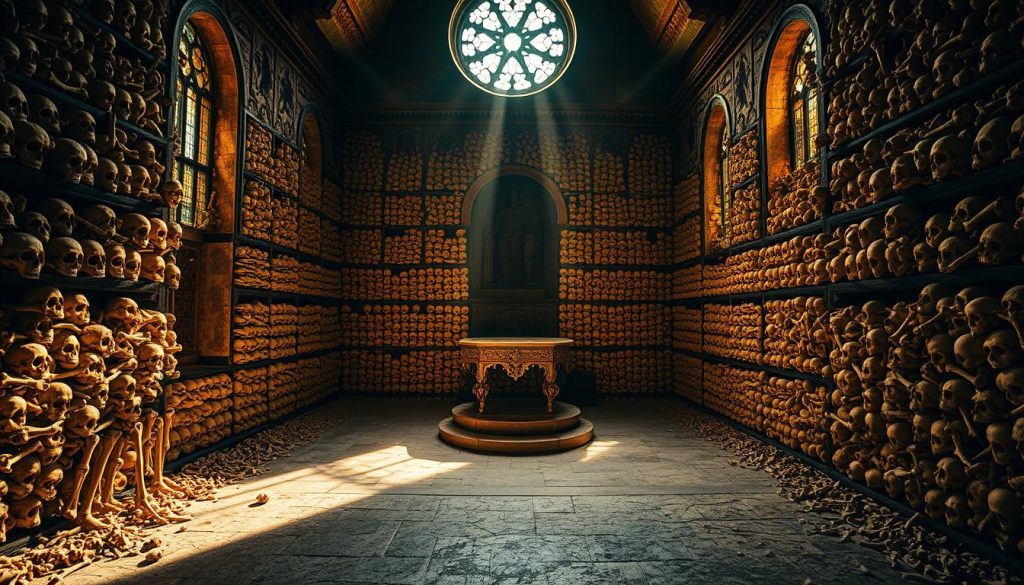
Eerie Beauty and Symbolism
The chapel is more than just a macabre display. It serves as a reminder of life’s transience, with an inscription above the entrance that reads: “These bones that lay here wait to welcome yours.” This powerful message invites visitors to reflect on the fleeting nature of existence.
The arrangement of over 5,000 skeletons is both artistic and symbolic. Each bone tells a story, offering a glimpse into the lives of those who once walked the streets of this historic town. The chapel’s design is a testament to the monks’ craftsmanship and their desire to inspire contemplation.
What to Expect on Your Visit
When visiting the Chapel of Bones, plan to spend around 15 minutes exploring its small but impactful interior. The best times to visit are early morning or late afternoon to avoid crowds and fully absorb the reflective ambiance.
Here are some practical tips for your visit:
- Wear comfortable shoes, as the surrounding streets are cobbled.
- Respect the solemn atmosphere by keeping noise to a minimum.
- Take time to observe the intricate details and patterns created by the bones.
| Feature | Details |
|---|---|
| Opening Hours | 9 am – 5 pm (Nov-Mar), 9 am – 6:30 pm (Apr-Oct) |
| Entrance Fee | €5 (includes access to temporary exhibitions) |
| Best Time to Visit | Early morning or late afternoon |
The chapel’s small size allows for an intimate experience, but its impact is profound. Don’t miss the chance to explore this unforgettable view into history and human existence.
Experience Évora’s Iconic Cathedral and Heritage Churches
Discover the architectural splendor of Évora’s cathedral and its surrounding churches. These sacred sites are not just places of worship but also cultural treasures that tell stories of centuries past. The cathedral, in particular, stands as one of the foremost attractions for visitors seeking historical depth and artistic beauty.
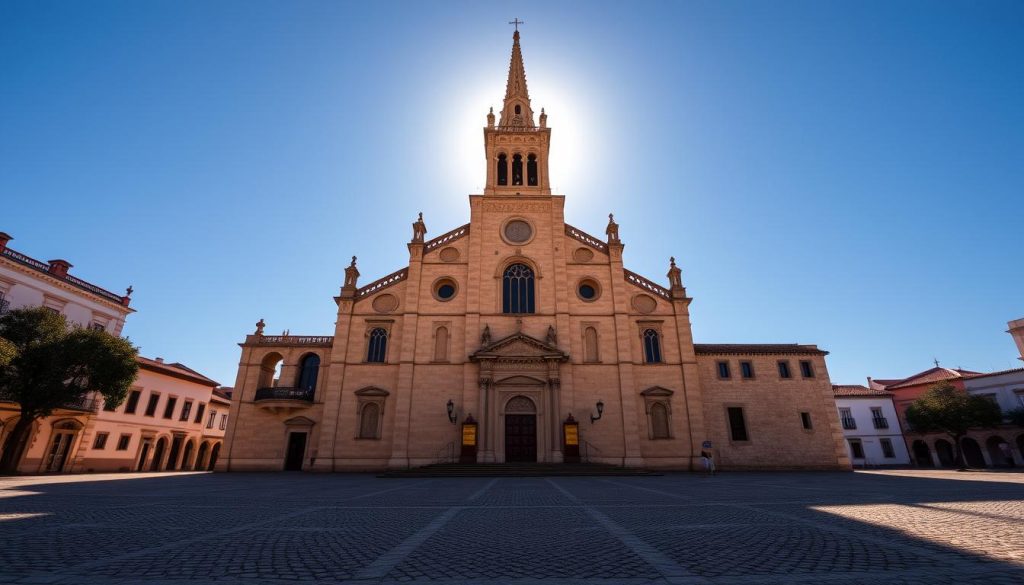
Stunning Rooftop Views and Cloisters
One of the highlights of the cathedral is its rooftop, offering panoramic views of the city. Climb the narrow stairs to witness a breathtaking perspective of the historic center. The cloisters, with their serene ambiance and intricate designs, provide a peaceful retreat for reflection.
The cloisters’ arches and columns showcase the craftsmanship of medieval builders. Each corner reveals details that reflect the cathedral’s evolution over time. Don’t forget to bring your camera—this is a view you’ll want to capture.
Architectural Highlights and History
The cathedral’s interior is a masterpiece of design, blending elements from Romanesque, Gothic, and Baroque styles. Its high vaulted ceilings, ornate altars, and stained-glass windows create a sense of awe. The treasury houses artifacts that highlight the cathedral’s role in the region’s history.
Built in the 13th century, the cathedral has witnessed significant events, including the blessing of Vasco da Gama’s ships. Its architecture reflects the cultural and religious influences that shaped the city. Guided tours are available for those who want to delve deeper into its history.
| Feature | Details |
|---|---|
| Opening Hours | 9 am – 5 pm (Nov-Mar), 9 am – 6:30 pm (Apr-Oct) |
| Entrance Fee | €4 (€5 including the treasury) |
| Best Time to Visit | Early morning or late afternoon |
Whether you’re drawn to its architectural grandeur or its historical significance, the cathedral is a must-see attraction. It’s a place where art, history, and spirituality come together in one unforgettable experience.
Stroll Through Charming Streets and Local Boutiques
Wander through the enchanting streets of this historic city, where every corner tells a story. The narrow, cobbled paths are lined with artisan boutiques and cozy coffee shops, inviting you to explore at your own pace. Each step reveals a blend of cultural heritage and modern charm, making it a delight for both history buffs and casual visitors.
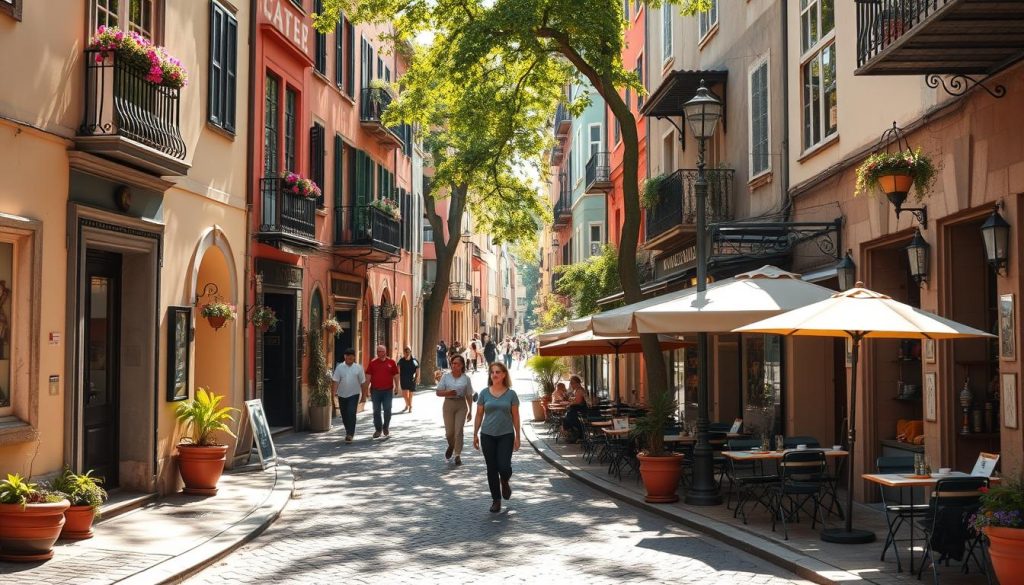
Hidden Gems and Boutique Shops
As you walk through the city center, you’ll discover hidden gems tucked away in every alley. Boutique shops offer unique souvenirs, from handcrafted pottery to locally made leather goods. These stores are perfect for finding one-of-a-kind treasures that reflect the region’s artistic heritage.
Local artisans take pride in their work, and their creations often tell stories of the city’s past. Whether you’re looking for a small keepsake or a statement piece, these shops have something for everyone. Don’t forget to stop by a café for a cup of coffee and a moment to soak in the atmosphere.
For those driving, designated parking areas outside the city walls make it easy to start your exploration. Once you’re inside, the best way to experience the city is on foot. The compact layout ensures that every street is within reach, and you’ll find something new around every corner.
Strolling through these streets isn’t just about shopping—it’s about immersing yourself in the everyday charm of this historic destination. Take your time, enjoy the sights, and let the city’s stories unfold before you.
Indulge in Authentic Alentejo Cuisine and Wines
Savor the rich flavors of Alentejo’s culinary traditions and wines. This region is a paradise for food and wine lovers, offering a blend of traditional recipes and modern culinary trends. From cozy family-run eateries to Michelin-starred venues, every meal here is a celebration of local culture.

Top Restaurant Picks and Dining Spots
When it comes to dining, the region boasts a variety of exceptional restaurants. Botequim da Mouraria is a must-visit, known for its intimate setting and authentic dishes. For a more upscale experience, try one of the Michelin-starred venues that showcase innovative takes on traditional flavors.
Here are some top picks:
- Botequim da Mouraria: A cozy spot offering classic Alentejo dishes.
- Fialho: A family-run restaurant with a rich history and delicious local cuisine.
- Esporão: Known for its wine pairings and exquisite tasting menus.
Must-Try Dishes and Local Flavors
No visit to the region is complete without trying its signature dishes. Start with “Açorda à Alentejana,” a hearty bread soup, or “Migas,” a flavorful dish made with breadcrumbs and pork. For dessert, indulge in “Sericaia,” a traditional egg-based pudding.
These dishes are a true reflection of the region’s culinary heritage. Pair them with a glass of local wine for the ultimate dining experience.
Wine Tours and Winery Experiences
Explore the region’s vineyards with a guided tour. The Alentejo Wine Route includes over 60 wineries, each offering unique tasting experiences. Visit Cartuxa Winery for its renowned Pera-Manca wines or Esporão for a diverse selection of single-varietal wines.
Here’s what to expect on a wine tour:
- Guided vineyard walks.
- Wine tastings paired with local cheeses and meats.
- Insights into the winemaking process and history.
Plan your visit during harvest time for a truly immersive experience. The region’s wineries offer a perfect blend of tradition and innovation, making every tour unforgettable.
Plan Your Visit: Transportation and Accommodation Tips
Planning your visit to this historic destination is easier than you think. Whether you prefer the freedom of driving or the convenience of public transport, there are plenty of options to suit your travel style. Once you arrive, the city’s compact layout makes it easy to explore on foot, ensuring a stress-free experience.
Getting There: Car, Bus, or Train
Driving is one of the most convenient ways to reach this destination. The journey from Lisbon takes about 1.5 hours, depending on traffic. Renting a car from reputable companies like Alamo, Hertz, or Sixt gives you the flexibility to explore the surrounding region at your own pace.
If you prefer public transport, the train from Lisbon is a great option. It runs several times a day and takes approximately 1.5 hours. Buses are also available, offering a budget-friendly way to travel. Both options drop you close to the city center, making it easy to start your adventure.
Where to Stay in Évora
Accommodation options range from upscale hotels to charming country stays. Octant Évora offers modern comfort with a touch of local charm, while Imani Country House provides a serene retreat just outside the city. For a unique experience, consider Convento do Espinheiro, a historic convent turned luxury hotel.
Here are some tips for choosing the right place to stay:
- Stay in the city center for easy access to major attractions.
- Consider a countryside stay for a peaceful retreat.
- Book early during peak travel seasons to secure your preferred accommodation.
Once you’ve settled in, the best way to explore is on foot. The city’s compact layout and pedestrian-friendly streets make it easy to navigate, ensuring you don’t miss any hidden gems.
Évora, Portugal: Best Things to Do – Top Picks: Your Ultimate Guide
Unlock the secrets of a city steeped in history and culture with this ultimate guide. Whether you’re planning a short visit or a multi-day adventure, this resource is designed to make your trip seamless. From iconic landmarks to hidden gems, every thing you need to know is right here.
Why This Guide Works for You
This guide is your go-to resource for exploring a UNESCO world heritage site. It’s packed with practical tips, detailed itineraries, and insider insights. Whether you’re a history buff, a foodie, or a casual traveler, this guide caters to all interests.
Here’s what makes it stand out:
- Comprehensive coverage: From must-see attractions to lesser-known spots, every thing is included.
- Day-by-day itineraries: Plan your visit with ease, whether you’re staying for one day or a week.
- Practical advice: Tips on transportation, dining, and accommodation ensure a stress-free trip.
Planning Your Itinerary
Organizing your visit has never been easier. This guide breaks down the top attractions into manageable day plans. Start with the iconic Roman Temple and Chapel of Bones, then explore the cathedral and charming streets. Each day is designed to maximize your time while allowing for flexibility.
Here’s a sample itinerary:
- Day 1: Explore the historic center, including the Roman Temple and cathedral.
- Day 2: Visit the Chapel of Bones and local boutiques.
- Day 3: Take a wine tour or explore nearby megalithic sites.
With this guide, you’ll experience the best of this UNESCO world heritage site without missing a beat.
Immerse Yourself in Culture and Artisanal Crafts
Dive into the vibrant cultural scene of this historic destination, where every corner tells a story. From ancient walls to modern galleries, the city’s artistic and historical treasures are waiting to be explored. This is your chance to connect with centuries-old traditions and discover unique handcrafts that celebrate the region’s heritage.
Museums, Galleries, and Historic Sites
The city’s museums and galleries are a testament to its rich history. Each site is part of a larger narrative, offering insights into the region’s past. The ancient walls that surround the city are not just a sight to behold but also a reminder of its resilience over the centuries.
Visit the local museums to see artifacts that span different eras. These collections provide a glimpse into the daily lives of those who once called this place home. The galleries showcase contemporary works, blending the old with the new in a way that’s both inspiring and thought-provoking.
Local Handcrafts and Artisan Shops
No visit is complete without exploring the artisan shops. Here, you’ll find handcrafted goods that reflect the region’s traditions. From pottery to textiles, each piece tells a story of craftsmanship passed down through generations.
Take your time to browse the shops and chat with the artisans. They’re often happy to share the history behind their creations. These unique souvenirs are more than just items—they’re a piece of the city’s soul that you can take home with you.
As you explore, remember that these crafts are part of a living tradition. By supporting local artisans, you’re helping to preserve a heritage that has stood the test of time.
Conclusion
Experience the charm of a city where history and culture come alive. From its ancient landmarks to its vibrant streets, every corner tells a story. The center of this UNESCO World Heritage site is a hub of activity, blending the old with the new in a way that captivates every person who visits.
Every year, travelers are drawn to this place for its timeless appeal. Whether you’re exploring historic sites, savoring local cuisine, or wandering through charming streets, there’s something for everyone. The city’s unique blend of heritage and modernity makes it a must-visit attraction.
Consider making this enchanting destination your next stop. Use this guide to plan your trip and uncover all the treasures it has to offer. Take the time to explore, reflect, and appreciate the beauty of this remarkable place.
The above is subject to change.
Check back often to TRAVEL.COM for the latest travel tips and deals.
